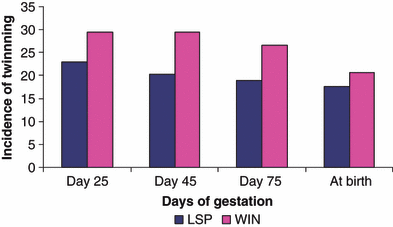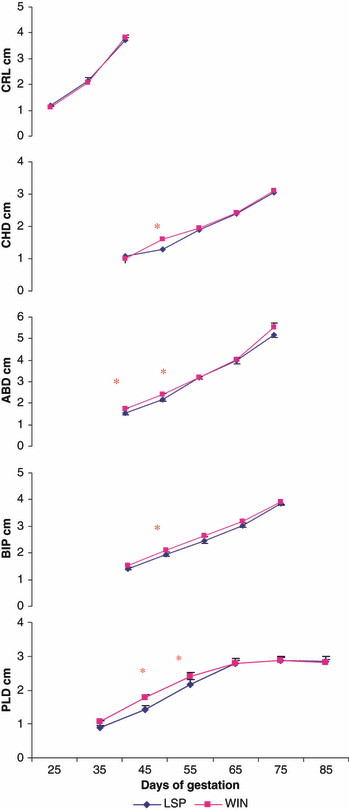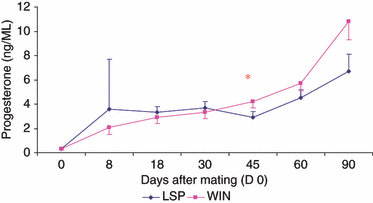Seasonal Variation of Reproductive Performance, Foetal Development and Progesterone Concentrations of Sheep in the Subtropics
Contents
The aim of the present study was to investigate the effect of breeding season [late spring (LSP) vs winter (WIN)] on reproductive performances, foetal development and progesterone (P4) concentrations of sheep in the subtropics. Ewes of Farafra breed were exposed for mating in LSP (n = 79) and WIN (n = 45). Ultrasonographic examinations were performed at days 25, 45 and 75 of mating to estimate the pregnancy rate, incidence of twinning and percentage of foetal losses. Foetal growth rate was determined at 10-day interval, and blood samples were taken on days 0 (oestrus), 8, 18 of oestrous cycle and on days 30, 45, 60 and 90 of pregnancy for P4 analysis. The results showed that pregnancy and lambing rates were greater (p < 0.01) for ewes mated in LSP (93.7% and 92.4%) than for those mated in WIN (75.6% and 71.1%), respectively. There was no effect of season on the incidence of twinning (overall 19.1%) or the frequency of foetal losses (overall 7.3%). Transient reduction of placental size, foetal growth and P4 concentration was observed following LSP matings. In conclusion, pregnancy and lambing rates were higher following LSP matings. Summer heat stress of the late spring mated ewes transiently interferes with foetal growth and P4 concentrations.
Introduction
The environmental temperature, photoperiod, geographical location and nutritional cues are major factors controlling the reproductive traits in sheep (Godfrey and Dodson 2003; Kleemann and Walker 2005; Marai et al. 2007). The combined effect of these factors on ewe fertility has been described in the temperate breeds (Notter and McClaugherty 1991; Lewis et al. 1996).
Heat stress for ewes kept in environmental chambers between days 50 and 75 of gestation has been reported to cause a reduction in placental weight (Vantick et al. 1991). Foetal growth retardation has been observed in these heat-stressed ewes. The effect of natural heat stress of summer season on placental and foetal development could not be traced in the available literature.
Several studies on the effect of continuous heat stress on plasma progesterone (P4) concentration in sheep kept in climatic chambers have been published (Wheeler and Blackshaw 1986; Bell et al. 1989). Heat-induced reductions in secretion of P4 and ovine placental lactogen more likely were a consequence than a cause of placental stunting (Bell et al. 1989). The available information on the peripheral P4 concentration of sheep exposed to natural summer is scant.
Farafra is a native fat-tailed breed that dominates in El-Farafra Oasis of the Egyptian western desert, from where it has been introduced to Mallawi Animal Production Research Station since 1992 (Galal et al. 2002). Little scientific information on reproduction function is available for this breed.
The objective of this study was therefore to evaluate the effect of breeding season [late spring (LSP) vs winter (WIN)] on reproductive performances, foetal development and peripheral P4 concentrations in Farafra breed in the subtropics.
Materials and Methods
Management
The current study was carried out at Mallawi Animal Production Research Station of the Animal Production Research Institute, which is located at latitude 28°07′N and longitude 30°33′E. The sheep flock was managed in an accelerated lambing system with three mating seasons per year, in January (WIN), May (LSP) and September (fall). The animals were housed in semi-open pens, and fed on concentrated mixture (0.5–1 kg/head/day, based on the body weight and gestational age) and clover hay or wheat straw that providing 14% crude protein (CP) and 70% total digestible nutrients (TDN). Supplementary concentrate of approximately 0.25 kg/head was offered 2 weeks prior to mating season for flushing, and during the last 2–4 weeks of pregnancy and the first week of lactation. The experiment was started in May breeding season and extended until lambing in October (average 50.17 ± 1% relative humidity and 34.6 ± 0.5 and 19.1 ± 0.5°C maximum and minimum atmospheric temperatures, respectively), and in January breeding season until lambing in June (average 59.25 ± 1.3% relative humidity and 19.85 ± 0.8 and 8.5 ± 0.6°C maximum and minimum atmospheric temperatures, respectively). Personnel, feeding and management factors were identical at each time.
Animals
Multiparous non-lactating ewes of native fat-tailed Farafra breed were introduced for breeding in May (LSP; n = 79; of 47.92 ± 3.1 months age and 43.53 ± 0.7 kg weight) and January (WIN; n = 45; of 43.0 ± 3.1 months age and 41.15 ± 0.8 kg weight). The mean interval from previous lambing to joining did not significantly differ between seasons (5.3 ± 0.3 months for LSP vs 4.9 ± 0.4 for WIN, p = 0.4). The ewes were kept far away from any ram before the beginning of the study and the rams used were the same ones between LSP and WIN. Ram to ewe ratio was 1 : 20.
Experimental design
At the starting of the study, ewes were divided at random into groups of 15–20 and joined with fertile rams for a 5-week period. The animals were checked for oestrus by teasers every 8 h, and those in oestrus were hand-mated. The incidence of ewes expressing oestrous behaviour was recorded. All ewes were examined ultrasonographically on days 25, 45 and 75 after mating to estimate and compare the pregnancy rate (ewes diagnosed pregnant at day 25), the incidence of twinning and the possibility of foetal losses (reduction in the number of embryos or complete loss of pregnancy). At lambing, the lambing rate (ewes lambing per ewes exposed), twinning percentage, lamb birth weight and gestation period were calculated.
Ultrasonographic estimation of foetal development
Ten singleton-bearing ewes per season were selected at random to estimate the patterns of late embryonic and foetal growth from day 25 until day 85 of gestation. The examination was performed at 10-day interval using a real-time, B-mode echo-camera (Hitachi, EUB-405B, Tokyo, Japan) attached with a 5/7.5 MHz transducer. At each occasion, the foetal crown-rump length (CRL, total embryo length); chest depth (CHD, dorso-ventral distance just caudal to the apex of the heart); abdominal diameter (ABD, diameter at the region of the umbilical cord); biparietal diameter (BIP, widest distance between the outer borders of the cranium at an angle of 90° to the falx cerebri) and placentome diameter (PLD, maximum diameter while it was in a cross-section) were recorded (Kahn et al. 1992).
Progesterone estimation
Blood samples were obtained by jugular venipuncture on days 0 (oestrus), 8, 18 of oestrous cycle and on days 30, 45, 60 and 90 of pregnancy from the same ewes of ultrasonic examination. Serum was harvested and stored at −20°C until assayed. Circulating concentrations of P4 were determined by RIA utilizing kits provided by Diagnostic System Laboratory Co. (DSL, Catalogue No. 3900, Webster, TX, USA). The sensitivity of the assay was 0.12 ng P4, and the coefficients of variance of intra- and inter-assay were 4.8% and 9.2%, respectively.
Statistical analysis
Differences in oestrous expression, pregnancy and lambing rates, twinning percentages and foetal losses were evaluated by chi-squared test. Repeated data including P4 concentrations, changes in placental or foetal parameters were analysed by anova for repeated measurements. Differences among groups for gestation period and birth weight were evaluated by t-test. Birth weight data were analysed with season and sex of the lambs entered in the model, while cases of twinning were excluded. Correlation model was fitted to evaluate the relationship between PLD and serum P4 concentration. Data were presented as mean ± SEM, and statistical analyses were carried out using SPSS (SPSS for Windows Ver. 10.0; SPSS Inc., Chicago, IL, USA) program, version 10.0. Level of significance was set at p < 0.05.
Results
Effect of season on reproductive performance
Table 1 summarizes the effect of season on reproductive performance of Farafra ewes. Oestrous expression tend to be higher in ewes exposed for mating in LSP, p = 0.1. Pregnancy and lambing rates were significantly (p < 0.01) greater in ewes mated in LSP. The mean number of lambs produced per ewe tends to be higher for ewes mated in LSP (p = 0.07). There was no significant effect of season, foetal sex or interaction between season and sex on the lamb birth weight. The mean birth weights of male and female lambs were 4.02 ± 0.1 and 3.79 ± 0.1 kg, respectively.
| Ewes, n | Oestrous expression, n (%) | Pregnancy rate*, n (%) | Lambing rate*, n (%) | Lambs/ewe exposed* (mean ± SEM) | Lambs/ewe lambing (mean ± SEM) | Lamb birth weight (mean kg ± SEM) | Gestation period (mean days ± SEM) | |
|---|---|---|---|---|---|---|---|---|
| LSP | 79 | 75/79a (94.9) | 74/79a (93.7) | 73/79a (92.4) | 1.17a ± 0.1 | 1.26a ± 0.1 | 3.78a ± 0.1 | 150.30 a ± 0.3 |
| WIN | 45 | 39/45a (86.7) | 34/45b (75.6) | 32/45b (71.1) | 0.93a ± 0.1 | 1.31a ± 0.1 | 4.01a ± 0.1 | 149.55 a ± 0.2 |
- Values with different superscript letters (a, b) in the same column differ significantly, p < 0.01.
- LSP, late spring; WIN, winter.
- *Pregnancy and lambing rates and number of lambs/ewe exposed were calculated to total number of ewes in each breeding season.
Effect of season on the incidence of twinning and foetal losses
There was no influence of season on the incidence of twinning (Fig. 1). Only one case of triplets was observed in ewes mated in WIN. The incidences of foetal losses were 6.8% for ewes mated in LSP (2.7% complete losses and 4.1% reduction in number) and 11.8% for ewes mated in WIN (3.0% complete losses and 8.8% reduction in number). This difference between seasons was not significant. For ewes mated in LSP, these losses occurred in 4.1% between day 25 and day 45 of gestation, and in 2.7% between day 45 and time of parturition. For those mated in WIN, the half of losses (5.9%) was observed between day 25 and day 45, while the other half was noticed between day 45 and day of parturition. Foetal mummification was not recorded in the studied ewes.

Incidence of twinning (%) at different stages of gestation in ewes mated in late spring (LSP, n = 79) and winter (WIN, n = 45)
Effect of season on foetal development
The patterns of antenatal foetal and placental growth are illustrated in Fig. 2. The mating season affected the pattern of foetal growth at day 45 and / or day 55 of gestation, when the dimensions of CHD, ABD, BIP and PLD were significantly lower (p < 0.05) in ewes mated in LSP, in comparison with those mated in WIN.

Growth pattern of the foetal crown rump length (CRL), chest depth (CHD), abdominal diameter (ABD), biparietal diameter (BIP) and placentome diameter (PLD) estimated ultrasonographically in ewe mated in late spring (LSP) and winter (WIN) seasons, n = 10 for each season. Values in means ± SEM. *Values differ significantly, p < 0.05
Effect of season on P4 concentration
Figure 3 illustrates the mean P4 concentrations in sera of singleton-bearing ewes mated in LSP and WIN. The levels were significantly (p < 0.05) lower at days 45 for those mated in LSP. A positive correlation (r = 0.75, p < 0.01) was found between serum P4 concentration and PLD at day 45 of gestation.

Serum progesterone levels during estrus cycle and pregnancy in sheep mated in late spring (LSP) and winter (WIN), n = 10 for each season. Values in means ± SEM. *Values differ significantly (p = 0.04)
Discussion
According to the present data, reproductive performance of Farafra breed is generally superior for ewes mated in LSP than those mated in WIN. For other breeds, especially in the temperate area, spring mating has been generally considered as a constraint of the sheep industry (Dzakuma et al. 1982; Brown and Jackson 1995; Casas et al. 2005). Genotype difference, climatic condition and ovarian activity throughout the year can partially explain this dissimilarity (Aboul-Naga et al. 1991; Noel et al. 1993; Bartlewski et al. 1998; Ali et al. 2006).
In this study, the mating season did not affect the incidence of foetal death. Similar results have reported by Dixon et al. (2007), where late embryonic or foetal losses were not related to the temperature–humidity index. Moreover, the patterns of loss were similar in ewes mated during the anestrous season and the transitional period and did not vary with service period within breeding season or method of synchronization of oestrus. In the present study, the incidence of foetal losses from day 25 of gestation until parturition is obviously lower (6.8–11.8%) than that reported for other sheep breeds (19–25%, Lunstra and Christenson 1981; Dixon et al. 2007). This may be attributed to the lower incidence of twinning reported for the Farafra breed. In this concern, there was some evidence that increased embryonic death in ewes occurs with an increase in the number of ova released. In superovulated ewes, most eggs are normally fertilized, but embryonic mortality increases with ovulation rate (Bindon et al. 1971).
Based on the present data, season affected the pattern of foetal and placental development significantly, but only on day 45 and or day 55 of gestation. This time of gestation coincided with the month of July, when the atmospheric temperatures were at a maximum (range 37–40°C). It has been reported that heat stress greatly reduces total cell number and placentome size resulting in foetal growth retardation (Bell et al. 1989; Early et al. 1991; Vantick et al. 1991). If this is true, why temperature affected foetal development at 45th and 55th days of pregnancy while August temperature is normally higher than July’s temperature and did not affect foetal development at 65th and 75th days? We hypothesize that early developed fetus (45–55 days) may be more susceptible to summer heat stress than the late developed one (65–75 days). However, this variation in early foetal growth rate was accompanied, in our study, by a little difference in the lamb birth weight. It is known that the rate of foetal growth during the second half of gestation is more important in determining the lamb birth weight, where the fetus increases in size of in a geometric-like curve, with the weight of the fetus increasing very rapidly the last trimester of pregnancy (Green and Winter 1945). In the current protocol, we could not follow the pattern of foetal development during the second half of gestation, because most of the foetal organ became too large to be measured by the ultrasound technique. To conclude this point, we suppose that heat stress of summer may cause a temporal impairment in the placental size and function, resulting in a transient reduction in foetal growth rate.
The drop in the serum P4 concentration at day 45 of gestation may be attributable to the reduction in the placental size observed during the same time. Supporting this opinion, a positive correlation between placentome diameter and peripheral P4 level was observed in this study. Effect of season on P4 concentration has been previously reported, where peripheral P4 concentrations during the luteal phase were greater in November than in February breeding seasons (Mitchell et al. 1999; Wallace et al. 1997; Xia et al. 2003). Others reported an interaction between breed and season for the peripheral P4 levels (Coelho et al. 2006).
In summary, these results show that, in the subtropics, reproductive performance of Farafra breed is superior following LSP matings. The incidences of twinning and foetal losses are relatively low with no influence of season. Summer heat stress of the late spring mated ewes transiently interferes with foetal growth and P4 concentrations.




